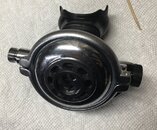elan
Contributor
Hi everyone,
I had some leftover 109 with many parts missing - a diaphragm, purge cover, adjustment knob, lever and the orifice also had a bunch of nicks on it. The case was in a good shape however.
I finally decided to dig through my parts box and try to make something working out of it. I dug out some S wing poppet which was left from another reg - I think one of the older 250 ies with a balance chamber and a spring. I had a VDH reproduction purge cover and I also found the adjustment knob from a G250 - the one with a plastic knob molded over metal shaft. But the other things were missing.
I found a broken M50 which had some plastic bits cracked in the case so it was garbage. But it still had some parts usable. Plastic orifice was in a great shape no visible nicks under 10x magnification even and my nail ran over the edge smoothly.
The lever and the diaphragm were in a great shape - the diaphragm was a bit dirty but after washing it well it looked brand knew. Stretching it did not uncover any holes or irregularities either.
After assembly the reg works well, just like any other 250v and BAs I have. My worry is whether I might get any issues with the diaphragm down the road because it does look slightly different more dome shape than those on BAs. It does properly fit however and I was able to tune it easily just like other BA/250.
The lever seems to be the same as used on G250Vs per SP schematics (2010) so I think it should not be an issue.
What do you think, should I look for a 250 diaphragm or just dive it as is. I will take it for a test dive sometimes next week.
Thanks in advance,.
I had some leftover 109 with many parts missing - a diaphragm, purge cover, adjustment knob, lever and the orifice also had a bunch of nicks on it. The case was in a good shape however.
I finally decided to dig through my parts box and try to make something working out of it. I dug out some S wing poppet which was left from another reg - I think one of the older 250 ies with a balance chamber and a spring. I had a VDH reproduction purge cover and I also found the adjustment knob from a G250 - the one with a plastic knob molded over metal shaft. But the other things were missing.
I found a broken M50 which had some plastic bits cracked in the case so it was garbage. But it still had some parts usable. Plastic orifice was in a great shape no visible nicks under 10x magnification even and my nail ran over the edge smoothly.
The lever and the diaphragm were in a great shape - the diaphragm was a bit dirty but after washing it well it looked brand knew. Stretching it did not uncover any holes or irregularities either.
After assembly the reg works well, just like any other 250v and BAs I have. My worry is whether I might get any issues with the diaphragm down the road because it does look slightly different more dome shape than those on BAs. It does properly fit however and I was able to tune it easily just like other BA/250.
The lever seems to be the same as used on G250Vs per SP schematics (2010) so I think it should not be an issue.
What do you think, should I look for a 250 diaphragm or just dive it as is. I will take it for a test dive sometimes next week.
Thanks in advance,.




